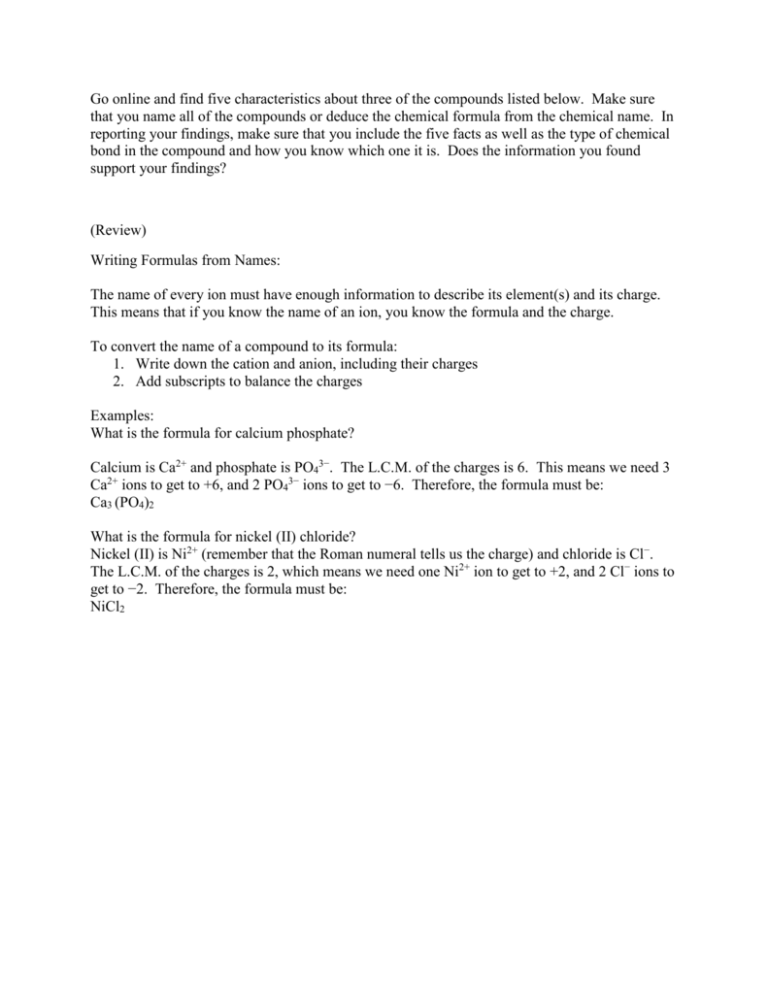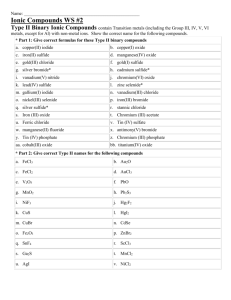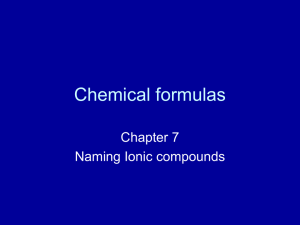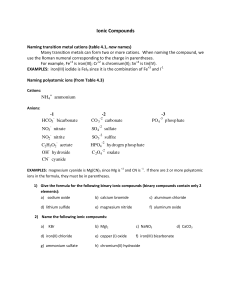File - Chemical Bonding
advertisement

Go online and find five characteristics about three of the compounds listed below. Make sure that you name all of the compounds or deduce the chemical formula from the chemical name. In reporting your findings, make sure that you include the five facts as well as the type of chemical bond in the compound and how you know which one it is. Does the information you found support your findings? (Review) Writing Formulas from Names: The name of every ion must have enough information to describe its element(s) and its charge. This means that if you know the name of an ion, you know the formula and the charge. To convert the name of a compound to its formula: 1. Write down the cation and anion, including their charges 2. Add subscripts to balance the charges Examples: What is the formula for calcium phosphate? Calcium is Ca2+ and phosphate is PO43−. The L.C.M. of the charges is 6. This means we need 3 Ca2+ ions to get to +6, and 2 PO43− ions to get to −6. Therefore, the formula must be: Ca3 (PO4)2 What is the formula for nickel (II) chloride? Nickel (II) is Ni2+ (remember that the Roman numeral tells us the charge) and chloride is Cl−. The L.C.M. of the charges is 2, which means we need one Ni2+ ion to get to +2, and 2 Cl− ions to get to −2. Therefore, the formula must be: NiCl2 Naming Ionic Compounds Practice Worksheet Name the following ionic compounds: 1) NH4Cl _____________________________________ 2) Fe(NO3)3 _____________________________________ 3) TiBr3 _____________________________________ 4) Cu3P _____________________________________ 5) SnSe2 _____________________________________ 6) GaAs _____________________________________ 7) Pb(SO4)2 _____________________________________ 8) Be(HCO3)2 _____________________________________ 9) Mn2(SO3)3 _____________________________________ 10) Al(CN)3 _____________________________________ Write the formulas for the following compounds: 11) chromium (VI) phosphate _____________________________________ 12) vanadium (IV) carbonate _____________________________________ 13) tin (II) nitrite _____________________________________ 14) cobalt (III) oxide _____________________________________ 15) titanium (II) acetate _____________________________________ 16) vanadium (V) sulfide _____________________________________ 17) chromium (III) hydroxide _____________________________________ 18) lithium iodide_____________________________________ 19) lead (II) nitride _____________________________________ 20 silver bromide _____________________________________ Solutions for the Naming Ionic Compounds Practice Worksheet 1) 2) 3) 4) 5) 6) 7) 8) 9) 10) ammonium chloride iron (III) nitrate titanium (III) bromide copper (I) phosphide tin (IV) selenide gallium arsenide lead (IV) sulfate beryllium bicarbonate manganese (III) sulfite aluminum cyanide 11) 12) 13) 14) 15) 16) 17) 18) 19) 20) Cr(PO4)2 V(CO3)2 Sn(NO2)2 Co2O3 Ti(C2H3O2)2 V2S5 Cr(OH)3 LiI Pb3N2 AgBr Naming Ionic Compounds Practice Worksheet Name the following ionic compounds: 1) NH4Cl _____________________________________ 2) Fe(NO3)3 _____________________________________ 3) TiBr3 _____________________________________ 4) Cu3P _____________________________________ 5) SnSe2 _____________________________________ 6) GaAs _____________________________________ 7) Pb(SO4)2 _____________________________________ 8) Be(HCO3)2 _____________________________________ 9) Mn2(SO3)3 _____________________________________ 10) Al(CN)3 _____________________________________ Write the formulas for the following compounds: 11) chromium (VI) phosphate _____________________________________ 12) vanadium (IV) carbonate _____________________________________ 13) tin (II) nitrite _____________________________________ 14) cobalt (III) oxide _____________________________________ 15) titanium (II) acetate _____________________________________ 16) vanadium (V) sulfide _____________________________________ 17) chromium (III) hydroxide _____________________________________ 18) lithium iodide_____________________________________ 19) lead (II) nitride _____________________________________ 20 silver bromide _____________________________________ Solutions for the Naming Ionic Compounds Practice Worksheet 1) 2) 3) 4) 5) 6) 7) 8) 9) 10) ammonium chloride iron (III) nitrate titanium (III) bromide copper (I) phosphide tin (IV) selenide gallium arsenide lead (IV) sulfate beryllium bicarbonate manganese (III) sulfite aluminum cyanide 11) 12) 13) 14) 15) 16) 17) 18) 19) 20) Cr(PO4)2 V(CO3)2 Sn(NO2)2 Co2O3 Ti(C2H3O2)2 V2S5 Cr(OH)3 LiI Pb3N2 AgBr









